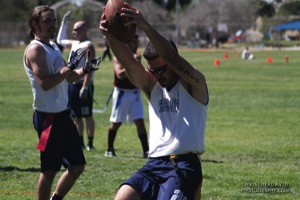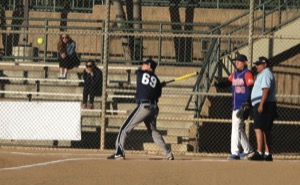
The first worldwide study shows homophobia in sports is still a major issue but San Diego continues to offer welcoming sporting leagues for the LGBT community
For anyone who has played a team sport, it should come as no surprise that sports are not always welcoming to the LGBT community.
However, although it’s widely known that there has been a level of homophobia in the sports community for decades, the issue is typically ignored and often unreported. It’s also common for many gay athletes to hide their sexuality from coaches and teammates to avoid conflicts.
Erik Denison, who is a member of Australia’s first gay rugby team, decided to conduct a study to find out the extent of homophobia in sports after discovering a lack of data on the topic. Out on the Fields, which is co-authored by Denison and Alistair Kitchen, was released earlier this month. It takes an in-depth look at the issues of homophobia in sports and shines a spotlight on some startling statistics.
“The research that has been done showed homophobia in sport was a major issue but it was often dismissed by sporting organizations as too small in scale or too limited in scope,” said Denison, study coordinator and lead author of Out on the Fields. “By conducting a massive, international study we were able to clearly understand the problem and also identify the areas that needed the most attention.”
Out on the Fields surveyed 9,494 people, including gays, lesbians, bisexuals and heterosexuals. Half of the participants were under the age of 30 and among the six English-speaking countries surveyed; the majority were from either Australia or the United States.
As expected, 80 percent of athletes, both gay and straight, have either experienced or witnessed homophobia at some point in their athletic career. The study found that the most common form of harassment were verbal slurs, which 89 percent of gay participants who had personally experienced homophobia reported. Bullying (35 percent), verbal threats (29 percent) and physical assault (19 percent) were also common among gay men.
While lesbians also reported experiencing all of the above, the occurrences were less common. Fifty-three percent of lesbians compared to 50 percent of gay men had personally experienced homophobia in sports. Lesbians reported verbal slurs being most common (82 percent), followed by bullying (20 percent), verbal threats (19 percent) and physical assault (8 percent).
“We were shocked and alarmed by the extent of homophobia that was discovered in sport,” said Denison. “This study was conducted to the highest possible standards of research possible and overseen by seven internationally respected experts so we know the findings are a pretty good indication we have a major problem.”
As a result of homophobia, 83 percent of gay men and 63 percent of lesbians reported hiding their sexuality in youth sports out of fear of rejection from teammates. Sadly, 78 percent of survey participants felt that youth sports weren’t a safe environment for LGB people.
“There was a unanimous view across all genders and sexualities and in all countries that youth team sport remains unsafe and unwelcoming to LGB people,” emphasized Denison. “This is a major concern. It would seem that young people are coming out of the closet more than ever before but they continue to face discrimination.”
The study also found that gay males under the age of 22 (62 percent) were more likely to report experiencing homophobia than older gay men (53 percent). This problem is especially rampant in school gym classes.
In addition to athletes, the study also looked at the experiences of gay spectators at sporting events. More than three-quarters of the people surveyed felt that openly gay spectators wouldn’t be very safe at a sporting event and 41 percent named the spectator stands as the most likely sporting environment for homophobia to occur.

“As a father I was really disappointed to hear how widespread homophobia is in some parts of sport, especially the PE classes and spectator stands where so many kids learn how to behave,” said John Eales, an international rugby legend and longtime advocate for ending homophobia in sports, in a press release. “I’m hoping the Out on the Fields research shines a light on the issue and helps raise awareness of the problem among coaches, athletes and parents because no child should feel unsafe or bullied while they’re playing sport.”
Unfortunately, staying in the closet is common among many athletes, from youths to professionals. For example, despite soccer being one of the most popular sports among gay men, the 2014 FIFA World Cup’s 736 participants surprisingly included no openly gay athletes.
“I was disappointed the study found so many people continue to experience and also fear discrimination but I hope this will start to motivate change at all levels,” said LA Galaxy soccer player Robbie Rogers, who is one of the world’s only current, openly gay male professional athletes, via press release. “National and international sports governing bodies, including FIFA, need to make committed and determined efforts to ensure LGBTI people feel welcome.”
Thankfully for San Diegans, there are lots of welcoming sporting leagues that are specifically tailored to helping members of the LGBT community feel welcome. From soccer to softball, there are LGBT-based teams for practically every sport in San Diego.
“San Diego is extraordinarily welcoming to LGBT athletes who wish to compete, regardless of their skill level,” Roman Jimenez, open division commissioner of the America’s Finest City Softball League (AFCSL), said. “In intramural or social leagues outside of the LGBT spectrum, however, it can be a different story but isn’t always.”
For instance, Jimenez noted that there are several softball teams in the league who also participate in non-LGBT leagues and feel welcomed by their competitors and spectators. However, not all leagues are as welcoming of LGBT athletes.
“Many players who play in our softball league have to come to us from some other so-called straight leagues where they’ve felt uncomfortable, unwelcome and even unsafe when their teammates found out they were gay,” Jimenez said.
The AFCSL was created specifically to give LGBT athletes a safe, welcoming environment to play sports. Since its beginning in 1981, the league has grown to include more than 600 players with more than 95 percent of participants being part of the LGBT community.
Other LGBT-friendly teams in San Diego include the San Diego Sparks Soccer Club and the San Diego American Flag Football League (SDAFFL).
The San Diego American Flag Football League joined the San Diego gay sports scene in 2004 and has rapidly grown to include 280 players among 16 to 18 teams. Although the majority of players are gay, the league accepts both gay and straight men and women.
“Though we were founded as a gay league, we take a lot of pride in the fact that 20 percent of our players are straight,” said Steve Cramsie, a SDAFFL board member. “We’re there to be friends, teammates, play a sport, hang out afterwards and have a good tie. Because of this, I am proud to say that homophobia has never really been an issue with the SDAFFL.”
Another safe sporting environment is the San Diego Sparks, which as the only openly gay men’s team in the San Diego County Soccer League plays against many straight teams. The team, which began in 1986, accepts players at all levels of experience and welcomes both gay and straight men to join.
“It’s my hope that one day leagues like the AFCSL aren’t necessary,” said Jimenez. “We started 34 years ago because we wanted to be a safe space for LGBT athletes to come together in sport and competition. Thirty four years ago, we were necessary because often the last place you would want to be as an LGBT person was next to a straight guy holding a bat.”
“I look forward to the day where we are safe everywhere and welcomed everywhere,” Jimenez continued. “This study tells me that while admirable, my hope of leagues like ours being unnecessary is a long, long way off. But that’s OK. We’re not going anywhere. We’re going to continue to provide a safe and welcoming environment for LGBT athletes to play ball.”











